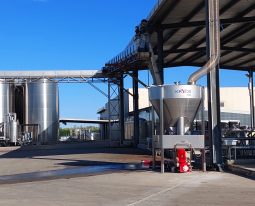
Even at the foothills of the Gran Paradiso in the Aosta Valley, climate change is imposing new conditions on grape processing due to increasingly early harvests and rising temperatures in the vineyards.
To defend the typicality of the wines, at the “Cave des Onze Communes” winery in Aymavilles, Kryos®, the system devised by SIAD for refrigeration of crushed and destemmed grapes in a protective, oxygen-free atmosphere by heat exchange through direct contact between crushed grapes and liquid CO2, has been tested.
The objective of these tests (reported in issue 83 of the periodical Oicce Times, authored by Massimo Bellocchia and Secondo Rabbione) was to compare the new system with traditional processing, in order to identify the solution capable of maximizing the extraction of aromatic precursors contained in the skins and limiting that of components responsible for the browning of wines. The use of Kryos® liquid CO2, for cold maceration, proved to be the most effective solution. In particular, the use of CO2 in its liquid state, compared to other refrigeration systems, allowed an increase in the aromatic component in a percentage between 20 and 40 percent.
Through the process of cold maceration of white grapes, the crushed grapes are refrigerated, bringing them to a temperature capable of inhibiting alcoholic fermentation. The main purpose of this process is to optimize the extraction of aromatic precursors contained in the skins, limiting the extraction of catechins and other phenolic components.
Various technologies are available on the market (heat exchangers, cryogenic gases such as carbon dioxide in a liquid or solid state, i.e., dry ice or carbon snow, or nitrogen in a liquid state), and the choice between one or the other system takes several factors into account: 1. Organizational and economic conditions of the company 2. Plant and technical equipment 3. Quality level to be achieved In this specific case, the “Cave des Onze Communes” winery covers 70 hectares of vineyards spread over 11 communes with altitudes ranging from a minimum of 550 meters above sea level to 900 meters. The grape varieties are aromatic and semi-aromatic white grapes, and production is 20 Doc wines, with an average annual output of more than 450,000 bottles. The experimentation aimed to compare two different techniques, the traditional one with a coil exchanger already in place and Kryos®, supplied by SIAD. Of 370 quintals of Müller Thurgau grapes, 100 quintals were vinified using the “traditional” cold maceration system, which involves destemming, sending the must into the lung tank, and then passing the must with skins through the snail exchanger to obtain a homogeneous mass at about 10 °C . The remaining 270 were treated with the Kryos® system, through which the crushed grapes from the de-stemmer were passed.
From the initial temperature of 17 °C, a chill of 7 °C was set, then increased to 13 °C as the heat brought the grapes to 23 °C. The next morning, after maceration, the liquid yield was evaluated under various conditions: • In the tanks before getting to the extraction of the skins: This yield was found to be 30 percent higher with the traditional system, because treatment with liquid CO2 results in the formation of much more homogeneous solid and liquid masses, so subsequent separation by stratification is longer • In just draining from the presses: it was 22% higher with the traditional system • In total liquid (the amount of liquid obtained from the first pressing cycles was added to the initial draining): the volumes obtained are equal because similar pressures lead to similar yields even on different masses The last physical assessment was the measurement of the amount of scum remaining in the tank after flotation. The mass treated with the Kryos plant left a more abundant residue of 8% because the much more thorough mixing, compared with the snail exchanger, generates more lacerations at the level of the skins
In addition to the cellar evaluations, analyses were performed on the two masses to verify, for the two different processes, the aromatic composition and oxidative state. Sampling was carried out at four times: • On leaving the press • After flotation • At the end of fermentation • At 40 days after the end of fermentation This showed that the CO2-treated mass, presents from the beginning with a higher level of catechins and polyphenols. The higher also the level of some aromatic terpenes (linalool, diol 1 and oxide C), the lower the content of copper, the main catalyst of oxy dactions, and the level of acetic aldehyde. From the end of fermentation onward, in both processes, catechin values tend to decrease similarly, aromatic substance levels increase instead, and copper concentration decreases.
Thanks to the experimentation carried out at the “Cave des Onze Communes” winery, it is confirmed that the effectiveness of using CO2 in the liquid state of Kryos® for the vinification of semi-aromatic white berry varieties with prefermentative maceration of the crushed grapes in the presence of the skins.
Compared with other traditional refrigeration systems, it has enabled product with: • An increase in the aromatic component assessable between 20 and 40% of the most significant compounds • Increased protection of polyphenolics (oxidizable catechins and total polyphenols), metals, acetaldehyde, and free sulfur. The result is, therefore, a high level of quality of the must and, consequently, of the wines obtained with the use of liquid CO2.
About us
SIAD Group, a century of history in gas production
Among Italy’s leading chemical groups, SIAD is a leader in the production and commercialization of the full range of industrial, specialty, and medicinal gases and related services. The business extends to sectors in synergy with that of gases, including Wine, Food and Beverage.